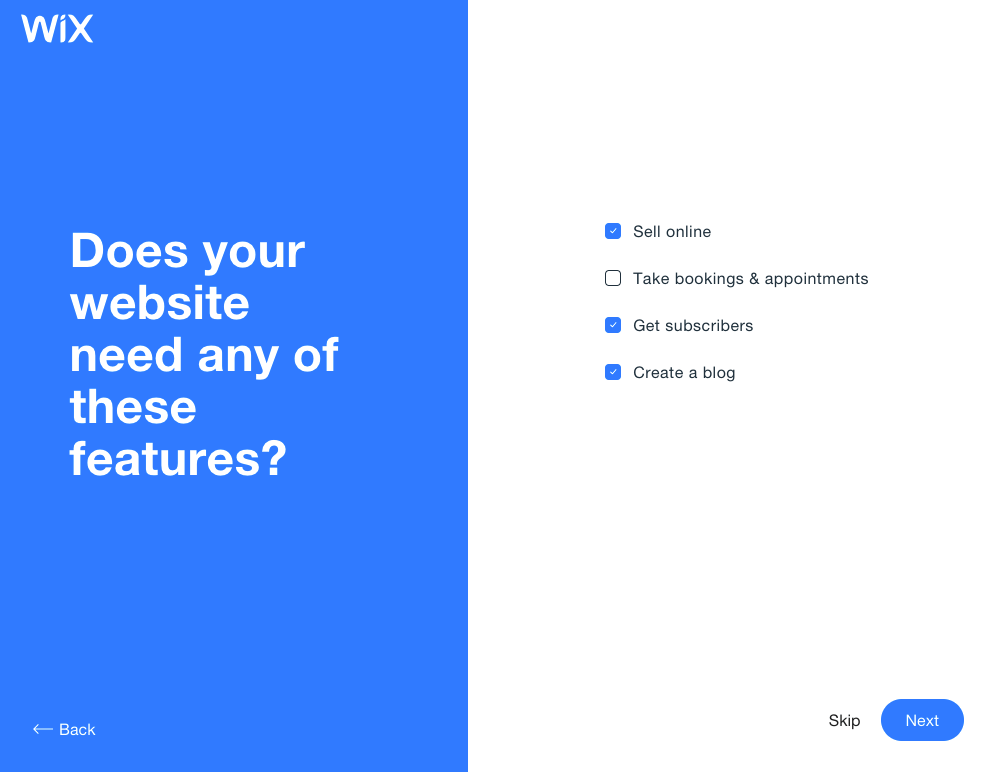Want to jump straight to the answer? The best website builder for most people is Wix.
You want a website—and you want it up fast.
But you also don’t want to sacrifice quality for speed. That’s where a good website builder comes in.
With the right builder, you can take your website from idea to reality in less time than it takes to watch an episode of your favorite show. It can also make it even easier by offering you stunning templates to create a site that looks great even if you have zero experience.
To find the best, I reviewed dozens of website builders, testing them on the quality of the product, from their ease of use and customer support to their pricing. I then narrowed them all down to my top five picks for the best website builders.
But my research didn’t stop there: I spoke to actual users of the website builders to get insights on their experience using them.
They talked to me about the good, the bad, and the things they absolutely loved about each of the builders. They also gave me their scores for platforms across three key metrics.
The 5 Best Website Builders
My top five picks are:
- Wix – Best website builder for your first website
- WordPress with Bluehost hosting – Best for building sites that grow with your business
- Squarespace – Best website builder for creators of all stripes
- Weebly – Best for making money with an ecommerce store
- GoDaddy – Best for building your website from your phone
As you read, you might notice that some users here and there didn’t give a score for certain criteria. That’s because they didn’t use the blogs for that purpose and couldn’t really speak to a site builder’s value in pursuing that end.
For example, I had one user who didn’t give a score for Wix’s “Ability to Earn Money” criteria simply because they weren’t using their website to earn money.
You also might find that the scores don’t necessarily impact the final rankings. That’s because I valued ease-of-use heavily in our final rankings.
That’s because most of you reading this will be beginners. We want to give you the best recommendations that’ll allow you to build the best site in no time, regardless of how experienced you are.
#1. Wix – Best Website Builder for Your First Website
- Robust AI-assisted builder
- Easy to use...
- ...but still quite customizable
- Excellent selection of themes
Total Score: 3.7
Ease of Use: 4.3
Depth of Customization: 4.3
Ability to Earn Money: 2.5

If you’re a beginner looking to build your first website, there’s a clear choice: Wix.
It offers a way that makes your website building experience painless and, dare I say, fun.
Seriously, their AI helps you create a website after answering just a few questions about your goals. It’s like taking a Buzzfeed quiz, but when you’re done you have a great website (instead of just wasting time during your work day).
All the users we spoke to attested to how easy Wix was to use—without sacrificing the quality of the final product.
“[Wix] is very intuitive and they give you great tools to create great websites,” one user told me. They also spoke very highly of the hundreds of templates the builder offered, praising the variety of great-looking designs along with “its easy-to-use drag-and-drop builder.”
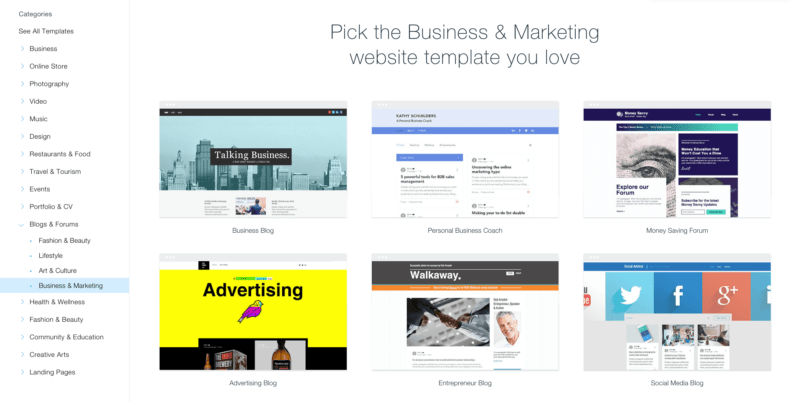
They have templates for music, art, fashion, health, travel, photography, construction, and restaurant sites—just to scratch the surface.
If you run a freelance handyman service, they’ll help set up a contact page or even an easy scheduler for folks to book you. Or, if you run a photography business, they’ll set you up with a nice, flashy portfolio page that’ll show off your best work.
Wix also offered numerous revenue streams for one user we talked to.
“My Wix website got me a few jobs,” they told me. “I’m also making consistent monthly income because of an online store I built on my site.”
Even though Wix offers a very user-friendly website builder, they also give you a comprehensive knowledge base of articles you can use if you ever get stuck.
“If I’m unsure about a certain topic, it’s quick to find via their support,” one user told me.
If you need a little bit more hands-on help, they offer a 24/7 callback service for US-based users so an actual person can walk you through any issues.
That’s a rarity in the website builder world—and definitely something that’ll help you in the long run. That way, if something breaks or your website crashes, you can immediately call someone up to help you.
Of course, I wanted to test it out for myself, so I jumped in and created my very own Wix page from scratch.
Building a Website with Wix
When I set up my Wix account, I was surprised to find that they actually gave me a few ways to create my own website.
First, I could get my hands dirty and choose a template and build my website from the ground up.
Or, I could simply answer a few questions about the type of website I wanted to build and Wix’s ADI builder would handle all of the work for me. Seriously, I had a decent-looking site after just a few answers.
The templates were indeed varied and good looking. Once you pick one, you can update everything from the font, logo, and colors to images and more. That means you can make any of the already great-looking templates all your own with a little bit of tweaking.
When I tested Wix, I loved how easy it was to find a template that matched our vision. The AI stayed with me as I edited the page, helping me pick the next thing to edit and showing me how to do it.
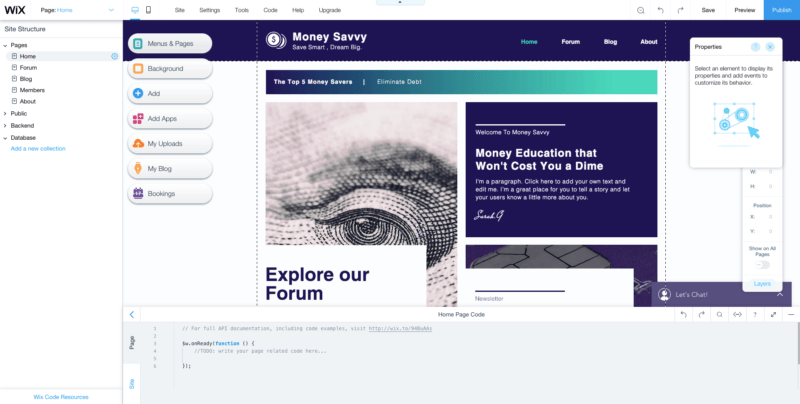
The Wix AI matched my new site to my existing social media accounts, used my logo to create a color palette for my site, and gave me a template pre-populated with that logo and our street address. Connecting images from existing social media accounts made it easy to pull in all the assets we already owned.
A fun thing to try is to pick a business you already know and see how close Wix’s AI comes to replicating it. I used a local yoga studio as an example and Wix did closely match the studio’s existing site. Even better, I bet they paid a web designer a bit for their design and I did mine for free with an AI assistant.
Cons of Wix’s Website Builder
Take note: all of Wix’s plans are automatically set to auto-renew. Sticker shock is real, especially if you signed up with an introductory promo pricing. As one of our users put it, “the price per month tends to be quite high.”
That can be a big deal if you’re, say, a scrappy startup trying to make and save as much as possible. If you want to recoup some of the expenses with an ecommerce site, you’ll still have to pay for a more expensive plan for the subscription fee.
Our panel scored the site low on its ability to earn you money. Granted, this could be just because our panel wasn’t entirely focused on generating direct revenue from their site aside from the user with ecommerce.
Still, it’s important to keep in mind that while Wix might not be the best for making money directly from your website (I also don’t recommend it for ecommerce), the beautiful website templates can help you create a great portfolio or professional website that’ll lead to other opportunities like connecting you with clients or even job offers.
Most of our users we spoke to did use Wix to build their own personal portfolios and blogs. That allowed them to find clients and customers.
Since Wix occasionally features their own users on their official blog, it can lead to more opportunities for you if you choose the platform. That’s exactly what happened to one of our users who said, “Being featured on Wix got me some freelance opportunities and ultimately landed my full-time job.”
Why We Ranked It at #1
Overall, Wix offers the best combination of ease-of-use and customization to give most people reading this (users building websites for the first time) the very best experience.
That’s why we put it in the top spot. If you’re just starting out, you’ll want to definitely go with Wix.
Their themes are varied and fantastic. You’ll also be armed with the tools you need to customize its look and feel to your exact specifications—or pretty darn close.
Wix gives you the option to essentially build your website for you through their AI site builder. That’s an amazing feature that no other website builder we reviewed offers. It takes the guesswork out of everything, especially if you just want to get a website up and running right away.
Bottom line: Wix is the best website builder for beginners looking to build a beautiful blog right out of the box.
#2. WordPress with Bluehost Hosting – Best for Building Sites That Grow With You
- One-click WordPress installation
- Get a free domain
- Build a money-making site
- 30-day money-back guarantee
Total Score: 4.3
Ease of Use: 4
Depth of Customization: 4.3
Ability to Earn Money: 4.6

A quick disclaimer: WordPress is the content management system (CMS) we use here at Quicksprout. They don’t pay us to, mind you—we just really like the product. So, I can personally attest to how great it is.
We’re not alone either. If you use WordPress, you join the likes of Vogue, Bloomberg, and even Beyonce’s own website who use it as their CMS.

Not only is it highly customizable, but it’s also incredibly scalable. This is a CMS that can grow as large as you want, or be scaled back to as small as you want.
Don’t just take my word for it though; our users all thought the same thing.
“With no knowledge of WordPress when I started it was a bit of a steep learning curve but I figured everything out quickly enough,” said one user. “WordPress is very intuitive and if you can’t figure something out, you just have to Google it or check on YouTube and you will likely find an answer.”
Another user loved how flexible WordPress was. That’s because it’s an open-source application so the back-end code is widely available—allowing developers and creators to make their own themes, widgets, and plugins for the CMS.
That means there are a ton of different ways you can mix and match plugins and themes out there. And, if you want to get your hands dirty, you can jump into the backend yourself and customize your site to your heart’s desire.
WordPress also has more than 11,000 themes. Many of them are free, some of them are paid.
My recommendation: Go with a paid one if you can afford it. One of our users paid for their theme, customized the heck out of it, and made it their own.
The benefit of doing this is that your website will easily stand out from the rest. When you go with one of the popular free themes, it’s just going to look like hundreds of other WordPress websites. However, if you put in a little work—and a little money—you’ll end up with a site that’s uniquely you.
If you’re a little hesitant about paying for themes or plugins, might I direct you to how well WordPress scored for Ability to Make Money. All of our users built their sites exclusively to draw in leads, customers, and sales.
The CMS allowed them to do so with easily integrated ecommerce functions, as well as powerful SEO tools such as Yoast to help capture organic traffic.
“I was able to monetize my website using affiliate marketing,” one user told me, “along with infoproducts like ebooks and minicourses once my audience got big enough.”
This user runs a genealogy website dedicated to helping people connect with family members. They were able to use their ancestry-specific blog along with a popular newsletter to build a loyal community of readers (and therefore customers).
“One thing that helped with that was creating an email subscriber list and a newsletter using the Mailchimp plugin,” they said. “It’s a must-have if you really want to monetize your blog.”
Building a Website with WordPress
Like I said, this is what we use here at Quicksprout—so I’m very well-versed in WordPress.
That said, there is a little bit of a learning curve for new beginners. The backend dashboard can frankly be overwhelming.
The good news is that after just a little bit of exploring and experimenting, you’ll get the hang of it in no time.
From your dashboard, you’ll be able to do everything from creating new pages for your site, to crafting blog posts, to downloading new themes, plugins, or widgets.
The blog and page editor uses WordPress’ proprietary Gutenberg interface: a user-friendly blog and page creator that leverages drag-and-drop tools to help you create the page you want.
It’s not the What You See Is What You Get interface that Squarespace or Wix have—but it’s close. If you want to see what your page or blog post looks like in the final product, you’ll have to click on the Preview button at the top of the editor. That’ll open up a new tab with the preview of your page/post.
It’s much, much more intuitive than its old editor—and will give any other WYSIWYG editor a run for its money.
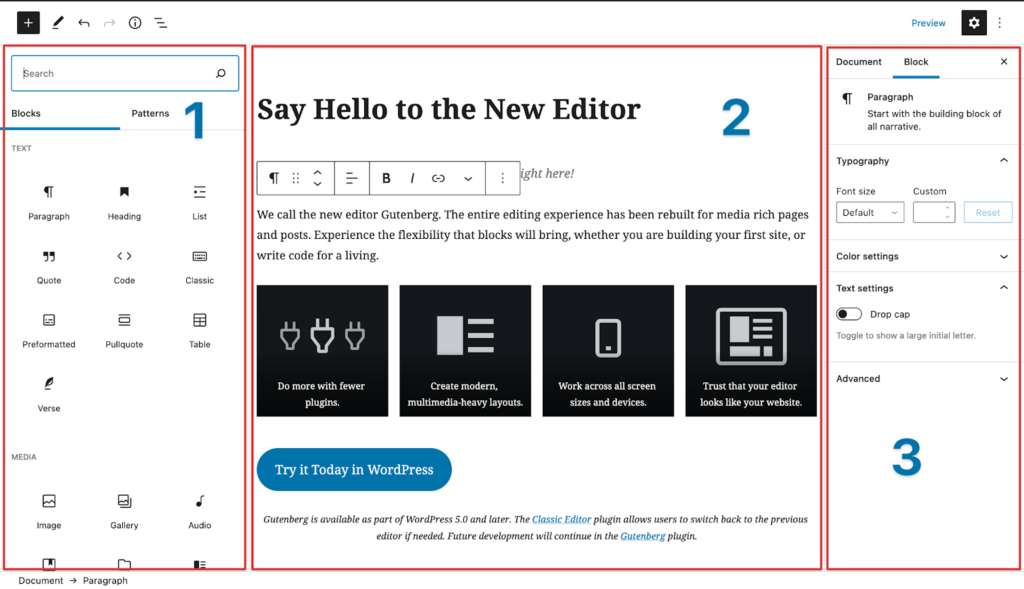
Like I mentioned before, WordPress is also incredibly scalable. If you want to build a big website with a ton of different assets, you can choose the right plugins to help. Or you can hire a developer (or yourself if you have PHP skills) to jump in the back end and build exactly what you need.
“WordPress gave me everything I needed to create the blog I wanted,” one user told us. “It gave me an easy interface to post my blogs, as well as everything I needed or wanted in my blog: a subscription box, an author area; just the look I wanted and the flexibility to change things as needed.”
There are a lot of different plugins out there, but I highly recommend you start small. My favorite plugin is Yoast SEO. It’ll help you make your page and blog posts rank better on Google search results by helping you find optimization opportunities in your content.
Choosing a Host
If you want to build a website with WordPress, they give you two options:
- Build it for free. This means your site will be hosted by WordPress. We don’t recommend this for a number of reasons. One of the obvious ones is that you’ll have to have a WordPress branded subdomain (e.g quicksprout.wordpress.com). Note: WordPress.com is their free, fully hosted version. If you want the self-hosted option (which I recommend), you’ll have to go with WordPress.org.
- Host it somewhere else. By hosting it elsewhere, you’ll get access to more resources and (potentially) a free unbranded domain name. This is where WordPress.org comes into play.
We have a lot more information about this in our article about the best web host and best web hosting for WordPress—but the short answer is choose Bluehost.
It’s one of the most popular web hosts out there. It’s also the one I highly recommend to beginners.
Every Bluehost plan comes with one-click WordPress installation, allowing you to easily create a website using the CMS once you sign up.
Each plan also comes with a free domain name registration too. In one fell swoop, you’ll be able to get a great domain, set up powerful and affordable web hosting, and create your WordPress site. Triple win!
All of our users surveyed used the powerful combination of WordPress with Bluehost. “I’m still using Bluehost after four years for most of my sites,” said one user. “It’s great for beginners due to how the pricing model is structured.”
Bluehost offers rock-bottom promotional pricing starting at just $2.75 per month. That’s right. For less than that cold brew you get each day at Starbucks, you’ll be able to get solid web hosting.
Every Bluehost plan comes with 24/7 customer support. You’ll be able to email them directly and they’ll help solve your issue as soon as possible.
That was the case for one of our users when their website crashed—but they said, “I contacted their chat support and they were able to identify the issue (a broken plugin) and fix it immediately. [I’m] very grateful for that.”
They’ll also help you migrate to their host if you’re coming from a different hosting service. This can easily be the biggest headache for any website manager—but Bluehost makes it a snap.
“The website migration was unbelievably easy!” one user told me. “And I really prefer the portal at Bluehost compared to the old place plus the service is better for me.”
Cons of WordPress’s Website Builder
When it came to the drawbacks, our panel agreed on one thing: It’s not the most beginner-friendly website builder.
In fact, they each told me about their frustrations when using the CMS for the first time. One user said, “I don’t like how it does take a bit of a learning curve to use. Sometimes I’d like to have my hand held more through the [website creation] process rather than having to look up a bunch of YouTube how-to videos to learn how.”
The dashboard is pretty complex at first blush. Once you learn it, though, you’ll be able to jump into the backend of any WordPress website and know how to get around with ease. This can be an incredibly valuable skill set to have—and one that employers frequently look for.
Still, this isn’t going to be the website builder for you if you’re looking to easily create a website out of the box with little to no site building experience or knowledge needed. For that, we recommend you look towards Squarespace or Wix instead.
But if you’re willing to put in the work, learning even just the basics of WordPress can result in a massive return on investment. Not only will you be able to create a fully customized website, but you’ll have a valuable skill employers definitely look for.
Another thing to mention is that WordPress doesn’t have the most comprehensive support system. “I wish there was a help desk that you could contact either by email or chat,” one user opined.
In fact, the only option WordPress really offers for support is just a forum where you can pose questions or bring up issues you’re having with your site.
I decided to jump in and test it out and posted a question about a fake issue I was having with my website. It took about two hours before I received a reply. While the answer was comprehensive and answered my question, it still took two whole hours before it was answered.
If I had a business and relied on that income to keep my lights on, those two hours represent my livelihood. I’d sure as heck like them to help me out faster than that..
Why We Ranked It at #2
WordPress scored very well across all three criteria due to its customizability and scalability.
Our panel of users also really liked how easily they were able to monetize their blogs to turn their websites into income generation engines.
While there are some issues here or there with the learning curve, once you get the hang of it, we promise you won’t look back. By the end of it, you’ll have a website that is endlessly customizable—and it’ll be able to grow as big as you or your business gets.
That means if you’re creating a blog for your passion, and the blog grows a big audience, you’ll be able to turn the same WordPress blog into a website that generates revenue for you from your audience.
Bottom line: It’s going to take a little bit more elbow grease, but once you create a WordPress website, you’ll have an incredibly customizable website that you can make into whatever you want it to be. Couple that with Bluehost and you’ll be able to do so easily in one fell swoop.
#3. Squarespace – Best Website Builder for Creators of All Stripes
- Stellar, beautiful templates
- WYSIWYG builder
- Tweak templates to make designs your own
- Ecommerce features
Total Score: 4.6
Ease of Use: 4.6
Depth of Customization: 4.6
Ability to Earn Money: 4.6

Squarespace is easily one of the visual website builders out there. That means visual assets like photos, illustrations, and graphic designs are typically front and center with any Squarespace website.
After all, it’s no coincidence that everyone in our panel had creator-focused websites. These users included a web design expert who teaches students how to create jaw-dropping sites, and an interior design blog who features gorgeous home tours on their website.
The reason they chose Squarespace is because of how easy it is to create a visually impressive website. In fact, our panel rated it very highly across the board because of those exact reasons.
“I think I had my blog up and running within a day,” said one user. “Squarespace offers clean, beautiful templates you can easily tweak.”
Building a Website with Squarespace
Jumping in, I found that Squarespace does indeed give you an easy way to start a blog just like Wix. However, I had to admit that as much as I liked Wix’s themes, Squarespace would take home the Best In Show ribbon for how gorgeous their themes looked.



The backend editor is also fairly intuitive. That’s great for beginners like the newly graduated graphic designer looking to build their portfolio, or the photographer who wants to make their first business website.
They’re also great for the new generation of creators and influencers across platforms like YouTube or TikTok to create a home for your brand outside of those platforms. Squarespace plays especially well with YouTube allowing you to embed videos along with more information or content that exists solely on your website.
“They have a great What You See Is What You Get builder,” said one user. “That means when you’re building the page, you see what the page will look like as you’re building it.”

In fact, this is something that builders like Squarespace and Wix have an edge on WordPress. You can easily see the changes you’re making to your website as you’re making them. No clicking back and forth between preview windows.
This can make it incredibly easy to use if you’re just starting out. Heck, even seasoned website managers might find it a breath of fresh air compared to the alternative.
“Sometimes, like in WordPress, you’re editing your site in the backend, but then you have to go to the front end to see what it’ll look like when you’re finished,” the user said. “With Squarespace, as you’re building the blog post, you’re seeing the changes happen at the same time. And I think that’s really, really useful. That’s one aspect that makes it really easy to use.”
Cons of Squarespace’s Website Builder
While Squarespace ranked fairly high on customization, it was still an area of some contention for our panel of interviewed and surveyed users.
One user enjoyed what Squarespace offered in terms of customization options and extra tools such as an ecommerce function, integrated email marketing, and podcast support. However, it’s still fairly limited when compared to the enormous customizability of WordPress. Not to mention, you might have to pay more for the plugins and widgets you need to make certain things work.
“Custom CSS is only available in the Business Plan,” said one user. “It’s doable for my website, I found some great tutorials on the internet for extra CSS customization and I had to buy a sidebar plugin because it wasn’t integrated in my template. For more complex websites this might be a problem.”
Mobile customization is also an area our users flagged. One user found it particularly frustrating since they essentially had to create your website twice—once for desktop and another time for mobile.
But, it should be noted that the Squarespace version you use might result in a different desktop vs mobile experience. For example, Squarespace version 7.0 might have templates that include extra built in mobile styles that’ll make your site look differently depending on what device you’re using to browse.
And while the website builder is easy to use, it could certainly be more intuitive. This is an area where Wix has an edge on Squarespace. One user told us, “It could be more obvious how to perform certain actions. Sometimes you have to hunt and click here and there. Every now and then I’ve accidentally deleted a blog because I’ve clicked the wrong button.”
Why We Ranked It at #3
Squarespace is a very good website builder, having ranked well across all our criteria. The users all had glowing reviews of the platform’s templates in particular.
However, it’s a notch below WordPress due to customizability and scalability.
You’ll be able to create a good looking blog or portfolio. But if you’re really looking to scale up your website for tons of traffic, you’d be better served going somewhere else.
It’s also not as intuitive as Wix so we had to put it lower on the list. Our users expressed a little bit of frustration using the Squarespace dashboard and opined its mobile customization.
But the website builder’s gorgeous templates and creator-friendly features earned it a spot on the list at #3. Their designs truly can’t be matched.
Bottom line: If you’re a creator looking to show off stunning visuals of your art, photographs, graphic design, and more, then Squarespace is the builder for you.
#4. Weebly – Best for Making Money with an Ecommerce Store
- Most reasonable ecommerce plans
- Intuitive store builder
- Sell services and physical & digital goods
- Easy payment integration
Total Score: 4.4
Ease of Use: 4.6
Depth of Customization: 4.3
Ability to Earn Money: 5

Weebly is another flexible, out-of-the-box website builder in the family of Wix and Squarespace. However, where they really stand out is their ecommerce functionality.
Their ecommerce builder plans are some of the most affordable out there—even lower than Wix or Squarespace. In fact, they have a free plan that gives you very basic ecommerce functionality at no cost at all. If you’re a beginner looking to step up from your Etsy shop and own your platform, I highly recommend Weebly.
In fact, their ecommerce functionality was one of its standout elements for our panel of users who ranked it a perfect five across the board for profitability.
Our panel members ranged from a musician who used Weebly to sell music directly to fans, to a LinkedIn coach and blogger who sold her coaching services via sessions directly on her website, to a website designer who used her Weebly site to bring in new clients.
“I chose Weebly to design all of my websites years ago with the idea that it was simple enough that my clients could update their own websites,” said the web designer. That user went on to add that they purchased third-party Weebly templates to access even more design options for her clients and herself.
Ease of use was also a standout for our panel of users. One told us that they really enjoyed being able to set up their site “in less than an hour.”
“The themes are a perfect starting point though and provide more than enough for anyone to create their own website with little or no digital expertise,” the user added. “Once you know your brand color codes it is very simple to change the look and feel to your own brand, and you can build it up from there by adding your own images and testimonials.”
Weebly is also powered by Square—the folks behind the incredibly popular point-of-sale system. That means if you sell products in-person like at a farmers market, you’ll be able to easily integrate your POS sales with your website.
This is another area where Weebly edges out other builders like Wix or Squarespace. Where they offer that type of integration at a higher paid plan (Wix) or with limited integration (Squarespace), Weebly just gives it to you.
Building a Website with Weebly
After hearing our users glow about Weebly’s easy site building process, I had to jump in for myself.
True to their word, our users were right when they said it was easy. Weebly offers a very intuitive website creation process. It really is as simple as choosing a domain name and a template, and creating the site.
It’s also incredibly easy to add new pages to your website. One of our users told us that, “Creating the blog section of my website was super simple and took less than five minutes to set up.”
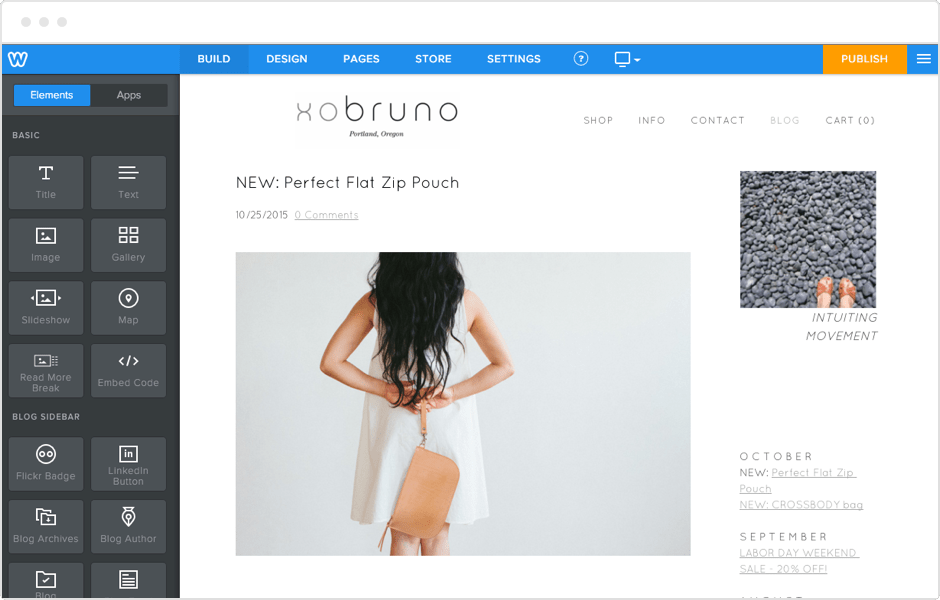
I found that Weebly integrates very nicely with other third-party tools that you’ll definitely want for your website such as Google Analytics and Mailchimp.
The builder itself is drag-and-drop a la Wix or Squarespace. So like those platforms, it’s very minimal effort and headache free. What you see is what you get.
There are tools for email, SEO, site analytics, shipping, and inventory for the ecommerce plan. You’ll be able to even add a product search to your online store—which I love. If you have a big catalog of products and services, you’ll definitely want to add this function in.
They also give you the ability to add badges to your products and services for when they go on sale or when inventory is low for a specific item. That’s a great way to build scarcity into your products—and make your customers want to click the buy button all the more.
Setting it up is simple and straightforward too. Since it’s a WYSIWYG builder, I can easily swap out products, prices, and descriptions, along with digital assets like logos, product images, and banner images. Setting up a very rudimentary store took less than five minutes to do after sign up.
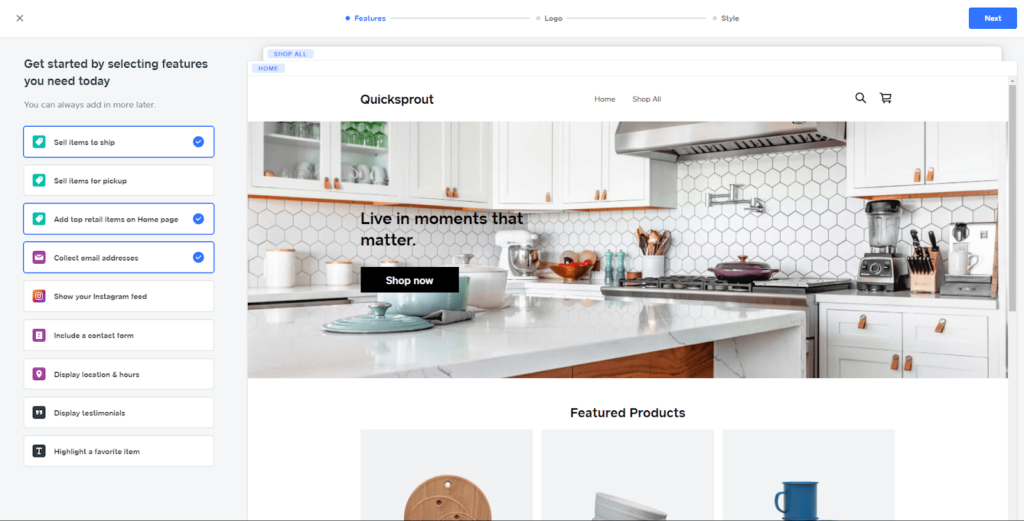
I was also pleased by how I was able to accept payments via gateways like Paypal, Stripe, and—of course—Square. Those options are a boon for users who will be able to pick the gateway they want.
Cons of Weebly’s Website Builder
One of our users didn’t like how Weebly doesn’t allow you to “save” changes on your site before it goes live. That would be a good addition if you were in the process of redesigning your site. If you have a ton of products on your store or if you have a lot of traffic coming in, this means if something goes wrong and breaks, it’s going to be much harder to fix.
Another user we spoke to didn’t like how complicated it was to sync up their inventory between their Weebly website and their Square POS system.
“Square and Weebly sometimes don’t cooperate with me or each other,” the user said. “So I can’t really have full, accurate inventory reflected between the two entities.”
That user also opined the fact that they had to jump back and forth between Square support and Weebly support if they needed help fixing an issue. It’s like a game of tennis and you’re the ball.
“If I want to fix something and I go to Weebly, they go, ‘No, go to Square,’ and Square’s like, ‘No, you have to go back to Weebly.”
Why We Ranked It at #4
Weebly offers a great and affordable ecommerce solution to website builders.
Like Wix or Squarespace, Weebly also lacks the comprehensive customization and scalability of WordPress.
Ultimately, I put it at #4 because a lot of folks reading this simply won’t need an ecommerce option. Many are just looking to create personal websites for their blog or portfolio. However, if you are a reader looking to create a simple store, I highly recommend going with Weebly because it makes the entire process dead simple for you.
Bottom line: If you’re building a website with an online store, choose Weebly.
#5. GoDaddy – Best for Building Your Website from Your Phone
- Best mobile site builder
- Build sites in minutes
- Easy-to-use editor
- Great for simple and short-term sites
Total Score: 3.7
Ease of Use: 4.6
Depth of Customization: 3.3
Ability to Earn Money: 3.3

On top of solid domain and hosting services, GoDaddy offers a simple and straightforward website builder.
It’s not necessarily the best at any one area—but think of it as “jack of all trades, but master of none.” From ecommerce websites to blogs to portfolios, they have tons of different templates to help you create the website that’s right for you.

If there was one single thing that GoDaddy does well though is its intuitiveness and simplicity. That was the biggest stand out for Gabriel Smith, one of the users we spoke to. In fact, Gabriel built his GoDaddy website all from his phone while he was homeless living on the street.
You read that correctly. He had just finished his memoir, also from his phone, and wanted to get his words out there. So he found GoDaddy and got to work building an entire website from his phone.
“I literally did it because I was homeless,” Gabe told me with a laugh. “What else could I do? Some way, somehow I was going to get my story out because I didn’t know how many people that could possibly help.”
Gabe was able to easily create his website using one of his few possessions: a smartphone. Using just the mobile editor, he was able to create a website that worked for him and his goal of promoting his book.
In his own words, he ranks GoDaddy’s ease of use at a five “only because ten isn’t an option.” So simplicity is definitely a strong suit for the website builder.
With some more hustle and grit, Gabriel was able to secure speaking engagements because of his book and website, as well as coaching opportunities to help out folks who were in a similar situation to him. Now, he has a successful career as a motivational speaker and a self-improvement author.
Building a Website with GoDaddy
I tried it out for myself and found that Gabe was correct. GoDaddy offered an incredibly intuitive way to create a website via a mobile editor or a desktop site builder.
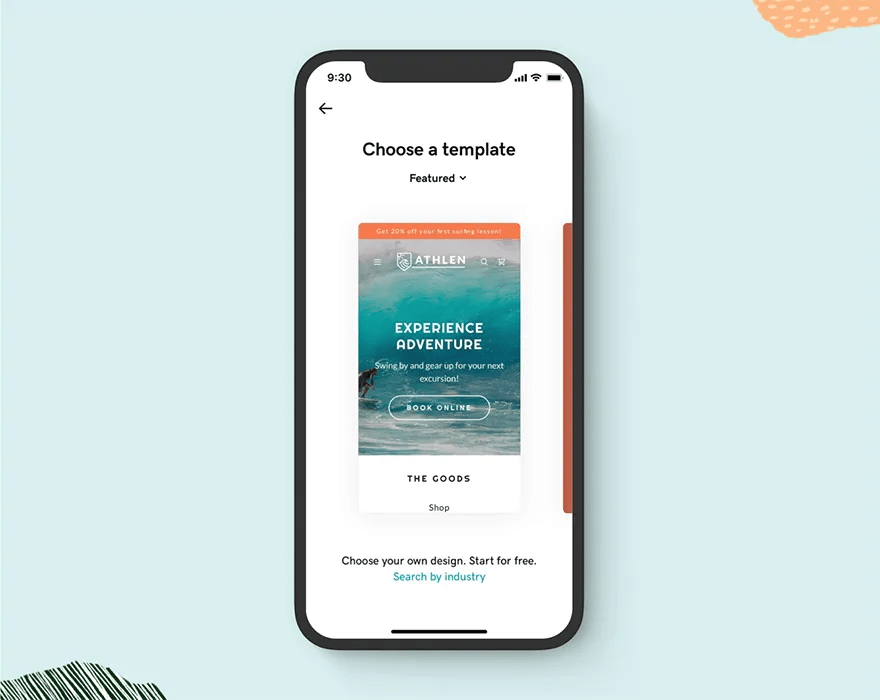
That’s not to detract from Gabriel’s immense accomplishment of building a successful website on his own while homeless, mind you—just verification that it is in fact easy to use.
I like that it gives you tools to book appointments, sell different products and services, and take reservations. Their drag-and-drop website builder makes it incredibly easy to do so too.
One user we spoke to owns a gardening shop and regularly offers classes. They said that they like the way GoDaddy “easily integrates appointments and workshops into the site.”
Our entire panel of users also really liked the tools offered—but occasionally wanted more. One user who owns a coffee roastery said they were “able to build an email list with our Godaddy website which is an extremely effective way to grow, but outside of that, the growth tools were limited.”
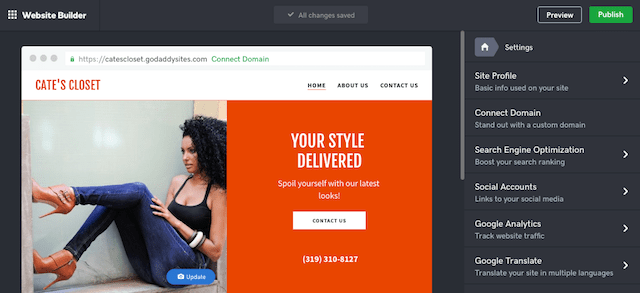
The simplicity is a boon and a drawback (as we’ll get into shortly). But overall, I really enjoy it because of how easy it is to use.
It’s pretty affordable though, with plans starting at $9.99 a month. I highly recommend it if you are already using GoDaddy for your domain or web host.
Cons of GoDaddy’s Website Builder
GoDaddy does seem to trade off simplicity for depth of customization.
In fact, they’re too simple in some ways. One user said that while the drag and drop editor was easy to use, it’s still “quite limited and you can’t easily alter things like font size.”
That user also criticized how slow the editing tool becomes if you have too many digital assets on the page.
Also, if you’re hoping to direct your emails to a portal of your choice, it’s going to be tough. “I think my biggest issue with them is their webmail that’s tied to the website,” one user said. “After a very frustrating season of my emails to customers constantly getting stuck in spam filters I had to give up and switch to Gmail for all correspondence. GoDaddy has not been able to fix the issue.”
They continued, “It’s a bummer because I’m paying for the service and I want to have that professional email address but I just can’t use it and have confidence that it will get to my customers.”
Another user actually recently switched from GoDaddy to WordPress because they felt like they had to “compromise on some aspects” of their website when building with GoDaddy.
“I wanted a store list of the physical locations people could buy our [products]. This didn’t exist,” said one user. They ended up having to get creative with a menu tool to create this page—but it obviously wasn’t ideal.
The user also added that, “The lack of ability to have recurring purchases for our [product] subscription service was also a big factor in deciding to switch from Godaddy to WordPress.”
Why We Ranked It at #5
If you’re looking to build a website easily and quickly and don’t expect to upkeep it too much, GoDaddy could be a good choice for you.
However, the platform simply doesn’t stand up against other comparable builders like Wix, Squarespace, and Weebly. GoDaddy doesn’t have the beautiful templates that Squarespace has, nor does it have the nice balance of customization, integrations, and ease of use of Wix, nor does it have the ecommerce capabilities of Weebly.
However, it’s a fantastic alternative if you’re a busy, on-the-go professional or someone who might be limited in the ways they can create their website looking for a dead simple website builder to get the job done.
In any case, Gabriel is more than happy to tell you how happy he is with GoDaddy—and that makes it a fantastic choice in my book.
Bottom Line: GoDaddy offers a simple, easy website builder—but not much else.
How We Chose Which Products to Review
I chose all five website builders based on three criteria:
- Ease of Use
- Depth of Customization
- Ability to Earn Money
I took a look at dozens of the most popular website builders on the market today, and benchmarked each of them against the three qualities above.
For each website builder I found, I created a free account with the blog sites and created a bare bones website to test out their tools and features. I also took into account the things offered in paid premium plans.
Using this method, I was able to narrow down my list of more than a dozen website builders to what I considered to be the five best. These five best showcased the three criteria above in unique—but effective—ways.
In all, this stage of the research process took two weeks to complete. When I finished, it was time to find real users of each product.
How We Reviewed Each Product
At Quicksprout, we believe that if you want to get actual insights about a product or service, you need to talk to actual users.
You can’t just trust the website builder’s marketing or even the testimonials you find on review sites. Instead, you need to find the people who have used the builders before. Only then can you get the good, the bad, and the oh-so-frustrating.
To find users and verify they actually had experience with the website builders, I made sure to do the following:
- Used an advanced search query that gave us results for bloggers using the platform for Squarespace and Wix.
- Find featured lists of actual users officially published by Wix, Squarespace, Weebly, and GoDaddy.
- Attaining a list of verified Bluehost customers and then using a simple page source check to verify that they also use WordPress.
- Checked each platform’s website for case studies of folks who have used their builders.
- Reached out to various local and popular businesses in every major US state, found their website, and checked the page source to see which builder they used to create it.
My goal was to find three users for each website builder. In all, I emailed and called roughly 120 users across each of the builders in order to get the fifteen featured in this article.
Each person agreed to either a phone interview or a survey. Questions for both were identical and included a rating of the product based on the three criteria on a five point scale (one being the worst; five being the best). The average of each user’s rating determined the final score of the product.
What We Learned Choosing the Best Blogging Platform
There’s no such thing as a “perfect” website builder. Instead, each one offers a unique set of features and tools for a different kind of user.
So the one you ultimately choose might be GoDaddy even though it’s ranked at number five on our list—and that’s just as valid as someone choosing Wix, which is at number one.
Don’t let the rankings get in the way of your decision. Instead, we’d like to offer a few pieces of criteria we used when choosing the products for this list. Let them guide your own research and ultimate choice.
Ease of Use
If you’re reading this, you’re likely a beginner. There’s absolutely nothing wrong with that. We all need to start somewhere.
However, what that means is that ease of use plays a bigger role in your ultimate decision than ever.
The reason is because it’s incredibly easy to get frustrated and burned out when learning a new skill like website building. That can easily result in abandoning your website building efforts entirely.
To combat that, you want to make things as easy as possible in the beginning. That’s why we highly recommend finding a platform that can help you create a site easily and quickly.
That’s why Wix is our top choice. It is the easiest way to get a website up and running quickly.
“[Wix’s] very intuitive and has great tools to create individual website designs,” one Wix user told us.
We also love that it will hold your hand through the process—and will even build out the website for you if you want.
That said, Squarespace, Weebly, and GoDaddy are also incredibly easy-to-use products as well. It just depends on what you’re looking for.
For example, if you’re looking for a great WYSIWYG website builder to create gorgeous blogs and portfolios, Squarespace is for you.
If you want to create a cheap but lucrative online store, Weebly is for you.
If you want an incredibly simple builder with a great mobile editor, look no further than GoDaddy.
Depth of Customization
Being able to customize your website to the exact look and feel you want is crucial—but it sometimes makes the learning curve for the builder a bit steeper.
This is a delicate balancing act. But once you strike it, the platform will allow you to not only align with your brand, but also draw in the type of readers and customers you want.
Customization also includes things outside of the way your website looks. It’s also the ability to add the features you need to accomplish your goals.
For example, if you want to build a list of email subscribers for a newsletter, you want to find a website builder that’ll allow you to easily capture your visitor’s contact information. For that you might want to go with Wix, Squarespace, or WordPress as they give you either native tools to do so or allow you to download a third-party plugin like Mailchimp.
Not all platforms offer the same amount of customization. A website builder like WordPress offers the deepest level of customization on this list. You’ll be able to create the exact website you want so long as you have the knowledge to code and edit, or are willing to pay someone to do so.
A website builder like GoDaddy offers likely the least amount of customization. That’s not to say you won’t be able to build a good website. They’re just not open-source. As such, there’s no community out there dedicated to creating widgets, plugins, and themes for GoDaddy sites.
A builder like Squarespace allows you to include things like ecommerce stores easily right out of the box.
“One of the reasons why I recommend Squarespace to small businesses or bloggers is because you don’t need to go get a third-party plugin to add a shop or to have your Instagram in the footer, or create your email newsletter collection,” said one of our users. “It’s really an all-in-one system, which is really wonderful.”
It all starts with the templates that they give you. You start with a theme, but are able to use it as a launching point. Once you tweak and customize it to your specific needs, it becomes virtually whatever kind of website you want it to be.
Ability to Earn Money
If you’re building a website for your business, or portfolio, or even a simple blog, you likely want to make money from it.
Websites are marketing channels after all. They exist to promote brands, products, services, movements, and more.
The website builder you choose will have a fairly big impact on how much money you can earn.
For example, if you want to build a good ecommerce store, I would highly recommend going with Squarespace or Weebly. They both have native ecommerce store builders.
However, Weebly is partnered with Square—and offers ecommerce features across all their plans (including the free one). So if you want to have a good way to make sure all of your sales system is in sync from inventory, to card swipes, to price changes, (while saving money) it’s the best choice for you.
If you run an info product business where you offer online courses, ebooks, and the like, WordPress is a great option for that. They offer a ton of great third party plugins to help you build a list and sell.
Sure, you won’t have out-of-the-box ecommerce functionality. But WordPress gives you a much higher ceiling in terms of being able to customize your website and creating even more avenues to revenue beyond sales.
Conclusion
Again, my top picks for the best website builders are:
- Wix – Best website builder for your first website
- WordPress with Bluehost hosting – Best for building sites grows with your business
- Squarespace – Best website builder for creators of all stripes
- Weebly – Best for making money with an ecommerce store
- GoDaddy – Most simple builder with easy management
Remember: There’s no one-size-fits-all solution. What works for one person or business, might not work for you—and that’s okay!
The point is you find a website builder that works for you. Forget all the rest.
No matter what, though, be sure to keep coming back to Quicksprout for the very best recommendations, tips, and tricks for building your website.
from Quick Sprout https://ift.tt/2PY83QK
via IFTTT

